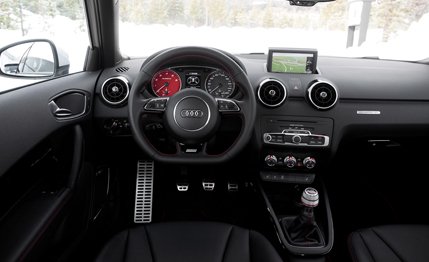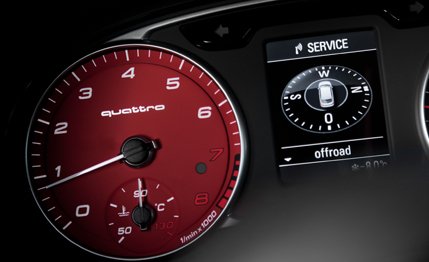 First Drive Review
First Drive Review
There are some special small cars that enthusiasts would kill for, including the mid-engined Renault 5 Turbo, the rear-drive Talbot Sunbeam Lotus, and just about any Group B World Rally Championship homologation car, such as the Peugeot 205 Turbo 16. Here's a potential new classic: the Audi A1 Quattro, priced at the equivalent of more than $55,000 and powered by a 256-hp turbo four. Production is limited to just 333 units. It will be by far the most powerful car in its class, the 208-hp Mini John Cooper Works being a distant second.
One Serious A1
In late 2010, an eight-person team came together to transform the VW Polo–based, front-wheel-drive Audi A1 into an all-wheel-drive high-performance monster. Previously, the A1 lineup was topped by a front-wheel-drive, 185-hp, 1.4-liter version, with a seven-speed dual-clutch automatic as the only available transmission. For the new top-dog A1, the engineers dug deep into the corporate parts bin and came up with the Audi TTS’s EA113 2.0-liter TFSI, MQ350 six-speed manual transmission, Quattro all-wheel-drive system, and rear suspension setup. This A1 offers no dual-clutch option, and it’s perfectly fine that way.
This car, after all, is serious business. We estimate the sprint from 0 to 60 mph will take 5.0 seconds; top speed is a drag-limited 152 mph, the result of aerodynamics tuned for downforce. When you fire it up, the A1 Quattro emits a sonorous hum, which turns aggressive as soon as you hit the throttle. The not-too-light clutch bites aggressively, but the transmission is exceptionally smooth and easy to operate. Punch the throttle and the four tires grab hard.

Its Quattro all-wheel-drive system is front-biased, but the setup can briefly force up to 100 percent of the torque to the rear wheels. Nevertheless, it takes aggressive turn-in and determined throttle action to induce power oversteer. If you’re not interested in playing drift king, the XDS system—a function of the stability control—can apply the brakes at each of the four wheels to better maintain your intended line through a corner. The XDS function stays active even with stability control switched off; those more comfortable with a safety net in place can select the Sport mode, which allows significant leeway before intervening. The electrically assisted steering is precise. Beefed-up brakes effectively keep speed in check, and sit behind 18-inch wheels wearing 225/35 Bridgestone rubber. Thanks to its excellent chassis, the A1 Quattro feels a lot lighter than its not-insignificant 3000 pounds would suggest.
As you can see, the A1 Quattro marks a significant aesthetic departure from its lesser kin. There are large front air intakes, similar to those on the monstrous Wörthersee A1 Clubsport Quattro concept. (Before you ask, that car’s 503-hp inline-five won't really fit in the production A1's engine bay.) The lower portion of the hatch is painted black, and there’s a huge wing on the roof. Exhaust gases exit through two polished four-inch pipes. Only the one color is available—Glacier White Metallic—with a black roof. The xenon lights feature a red "wing" that runs along the LED element. And about the wheels: They’re unique turbine-look pieces, styled like those on the Clubsport concept, complete with center lugs.
The interior is fitted with leather sports seats, a 280-kph (174-mph) speedometer, a bright-red tach, and a steering-wheel inscription that references the 333-car production run. It’s not an extremely comfortable car, but its one, fully equipped trim level does bring a number of luxuries. Included are automatic climate control; a large-screen navigation system; and a 14-speaker, 465-watt Bose sound system.

Big Changes for a Little Car
It was no easy feat to integrate all of the 600 modifications required to create the A1 Quattro—specifically, the bigger powertrain. For instance, Audi had to develop an entirely new gas tank that wraps around the driveshaft. But don’t think the company went through all of this trouble for a mere 333 cars. By 2013, there will be an S1, with the same all-wheel-drive system and a version of the 2.0 TFSI that will produce "more [power] than a Mini John Cooper Works," an insider promises. Figure on around 220 hp. Hopefully, the S1 will retain the A1 Quattro's six-speed manual, although an Audi development engineer intimates that the drivetrain could accommodate a dual-clutch automatic. And what about an RS1? Such a car may appear in the distant future, but we suspect that the A1 Quattro will be Audi’s mightiest mite for quite some time.